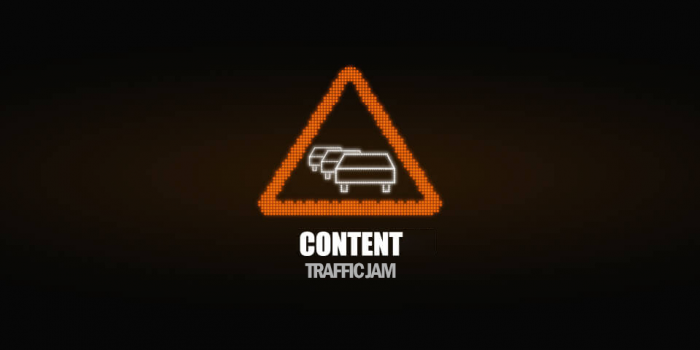
By guest author Benjamin Brueckner.
While marketing focuses on reaching the end consumer, PR is mainly communicating with media representatives. Naturally, there are overlaps between these two communications disciplines. But one challenge, in particular, is uniting the two departments:
The classic communications channels are as packed as JFK is on Wednesday before Thanksgiving. However, the difference is that the content traffic jam is not only happening around holidays, but has become a permanent condition. One has to ask the question: How can companies reach their audiences in spite of these communications traffic jams? Which detours are available?
The direct way is not always the shortest
Mathematically speaking, the shortest way between two points is a straight. But client acquisition or media relations is not following those rules. Marketing and PR professionals do not operate in a vacuum but often find themselves stuck in overwhelming waves of content rushing towards the audience. Press releases, pop ups, and all other content formats – the predicted information overload caused by too much content is real, not only for consumers on the receiving end but also for communications professionals who are sending the messages.
The consequence is that people start to automatically filter their media consumption, which makes it harder for companies to reach clients and journalists. Nevertheless, it’s not impossible.
No cutting through on highly-trafficked communications channels
Resembling a highway in LA, communications channels now often have to deal with miles-long traffic jams. Participants in these traffic jams are numerous publishers that try to get as fast as possible from Point A – their channel – to Point B – their audience, may it be a client or a journalist.
But what happens when communicators don’t follow the mainstream but make a turn to take a detour to get to their destination? With respect to communications, the question is: How can you reach your audience in a different way to avoid the content traffic jam on the major communications highways?

Targeting the personal environment
The importance of the personal environment is often underestimated, even though communications professionals mostly agree that word-of-mouth plays an important role in terms of buying decisions. A study showed that every third personal recommendation has led to a new sale. But not nearly all PR and marketing people make use of this fact to create campaigns that target the social environment of their clients.
When looking at the customer journey, people often focus on online and offline touchpoints with the brand. What is often neglected is the value generated by social interactions: a happy customer telling her friend about the new hair saloon; the employee who tells the CEO about a production company whose website he visited a couple of weeks ago.
Both examples show that the brands did not personally convince the friend or the CEO, but their social contacts did. Such recommendations can happen arbitrarily. Or they can be created.
The same applies for journalists. In this case, companies should focus on their own story and mission statement: An exciting founder’s story on the company website can inspire people to tell their journalist friends about the brand. Or it can inspire the journalists themselves.
Avoiding dead ends
To prevent detours from becoming a dead end, companies need clearly defined secondary target audiences that are in close relation to their customers and have certain level of influence. It is not effective to target a huge corporation’s interns with ads or PR pitches if their opinions are never hear by upper management.
A more goal-oriented approach is to target the levels below top management. There, you are more likely to find employees that can influence decision makers. A senior team member could, for example, convince the marketing director to work with a new innovative company by giving his or her recommendation.
However, with small businesses that have flat organizational structures, even a new and young employee could influence the owners by telling them about his or her recent experience with a new payment method, which can inspire the owners to implement it in the store.
So the question is: How can companies define which secondary target groups are right? The answer is: They have to analyze the social connections of their primary target audiences.

Three steps towards a clever communications detour
Three steps have proven to be working well for B2B as well as for B2C when it comes to defining your communications detour:
1. Define your primary target audience: Each service and product has to focus on a primary target audience. Marketing and PR have to focus their campaigns clearly on these targets, which is the normal practice.
2. Target the social environment of customers and journalists: Many advertising and communications professionals stop strategizing after this first step and move on with implementation. However, it is advisable to plan various side campaigns in support of the main campaign to target the social environment of the primary target audience.
3. Identify further social contact points: If you have done a thorough analysis of your primary target audience, you should know their hobbies: Which sports do they do, which cultural interests do they have? Based on these answers, you can create your supporting side campaigns that target additional potential social contacts.
An example: A granola bar brand sponsors a discount for a local gym membership. Automatically, trainers at the gym who recommend a membership will also promote the granola bar with it. In addition, the gym can also sell the granola bars at its locations.
The granola bar brand thereby achieves multiple communications objectives: Brand awareness, reputation management, customer engagement through secondary audience and increased sales. The gym can increase its membership numbers and new member benefit from a discount – a win-win situation for all participants.
// About the author

Benjamin Brückner is a journalist, blogger and founder of the online platform Freelance Start. After years of working in the editorial teams of radio and television stations, he published two books and is now working as an editor and newsletter director at Zielbar. On his personal blog, he regularly writes reviews, book tips and analysis of social topics. In his private life, he is interested in philosophy, history, sports, digital news and creative writing.
